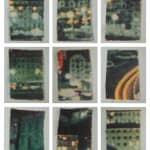Angus Fairhurst
Cities Pink Sound 1-9, 1991
Nine Chromogenic prints, each individually mounted on board and pierced with tags.
160 x 130 cms
62 15/16 x 51 2/16 ins
11970
Further images
-
(View a larger image of thumbnail 1
)

-
(View a larger image of thumbnail 2
)

-
(View a larger image of thumbnail 3
)

-
(View a larger image of thumbnail 4
)

-
(View a larger image of thumbnail 5
)

-
(View a larger image of thumbnail 6
)

-
(View a larger image of thumbnail 7
)

-
(View a larger image of thumbnail 8
)

-
(View a larger image of thumbnail 9
)

Provenance
Karsten Schubert, LondonPrivate Collection, London, acquired before 1996
9 chromogenic prints. Each photograph laid on board and pierced with multiple plastic garment tags, in nine parts. Each photograph 50.8 x 40.2 cms (20 x 15 7/8 inches) Total...
9 chromogenic prints. Each photograph laid on board and pierced with multiple plastic garment tags, in nine parts.
Each photograph 50.8 x 40.2 cms (20 x 15 7/8 inches)
Total dimensions approximately 160 x 130 cms
Angus Fairhurst was always deprecating about his own talent, but he made some of the most engaging, witty and perceptive works of his generation and was an enormously influential friend of other British artists who came to prominence in the early nineties.
Sir Nicholas Serota, 2008.
Angus Fairhurst initially gained acclaim at the end of the 1980s along with his contemporaries at Goldsmith's Art College, most notably his close friend Damien Hirst.
Earlier works used vastly enlarged postcard images whose surfaces were pierced by a close grid of plastic clothing tags. Fairhurst sees even this obvious index of consumerism as operating in a double-edged way. The tag does invoke the ersatz individuality of the processes of consumption, but it doesn’t entirely reject this aspect. Likewise, the tags penetrate the surfaces of the images. This may seem vaguely repellent, particularly when, as is often the case, the images contain people, but because of their size they also draw the viewer into a more intimate relationship with the image.
Michael Archer, Art Forum, 1993.
Each photograph 50.8 x 40.2 cms (20 x 15 7/8 inches)
Total dimensions approximately 160 x 130 cms
Angus Fairhurst was always deprecating about his own talent, but he made some of the most engaging, witty and perceptive works of his generation and was an enormously influential friend of other British artists who came to prominence in the early nineties.
Sir Nicholas Serota, 2008.
Angus Fairhurst initially gained acclaim at the end of the 1980s along with his contemporaries at Goldsmith's Art College, most notably his close friend Damien Hirst.
Earlier works used vastly enlarged postcard images whose surfaces were pierced by a close grid of plastic clothing tags. Fairhurst sees even this obvious index of consumerism as operating in a double-edged way. The tag does invoke the ersatz individuality of the processes of consumption, but it doesn’t entirely reject this aspect. Likewise, the tags penetrate the surfaces of the images. This may seem vaguely repellent, particularly when, as is often the case, the images contain people, but because of their size they also draw the viewer into a more intimate relationship with the image.
Michael Archer, Art Forum, 1993.








